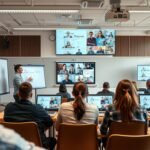Imagine a classroom that blends the best of both worlds. You get face-to-face connection with teachers and peers. Plus, you enjoy digital flexibility that fits your schedule.
This powerful combination creates a personalized learning journey. It adapts to your pace and style. You gain better access to resources and tools.
Modern education is evolving quickly. New tech and platforms are changing how we teach and learn. These methods help meet diverse students needs.
Educators play a key role in this shift. They create engaging courses using smart strategies. Your experience becomes more interactive and effective.
Key Takeaways
- Hybrid learning blends in-person and online instruction for flexibility.
- It offers personalized educational experiences tailored to individual needs.
- Technology platforms provide greater access to learning resources.
- These models enhance student engagement and collaboration opportunities.
- Educators are implementing innovative teaching strategies in hybrid environments.
- Hybrid approaches prepare learners for future educational and career challenges.
- This educational model is transforming learning systems worldwide.
Understanding Hybrid Learning: More Than Just a Pandemic Response
Many people think this approach started with school closures. But it’s actually a carefully planned educational method. It blends classroom time with digital tools for better results.
What hybrid learning really means for your education
This model combines physical classroom sessions with online components. You get direct interaction with instructors. Plus, you access digital materials anytime.
Your courses become more adaptable to your schedule. A Forbes survey shows 85% of educators notice higher student participation. They also report reduced teaching workload with this approach.
You gain more control over your educational journey. Digital platforms let you review materials at your pace. This creates personalized learning paths just for you.
Beyond emergency remote teaching: The evolution continues
Emergency remote instruction was a quick fix during crises. Today’s hybrid models are carefully designed for long-term use. They incorporate proven teaching strategies and modern technology.
Your experience now includes advanced learning management systems. These platforms organize your courses and resources efficiently. They support your progress through interactive content.
Educators continuously refine their methods based on data and feedback. This ensures your educational experiences keep improving. The focus remains on your success and skill development.
Collaboration tools enable teamwork regardless of location. You can work with peers on projects seamlessly. This prepares you for modern workplace environments.
The Current State of Hybrid Learning in Education
Today’s educational institutions maintain a delicate balance between traditional classroom experiences and digital enhancements. This approach creates richer environments for your growth and development.

How campuses have adapted post-pandemic
Most schools returned to full in-person instruction. However, they kept the best digital tools from remote teaching days. Your campus likely uses learning management systems daily.
Recorded lectures remain available for review. Accessibility features like closed captioning became standard. These changes support your unique learning needs.
AV/IT departments expanded their roles significantly. They now ensure classroom technology works seamlessly. This includes both physical equipment and online platforms.
The technology infrastructure that’s here to stay
Learning management systems became essential infrastructure. Platforms like Canvas and Blackboard organize your courses efficiently. They provide single-point access to all materials.
Real-time translation tools help diverse learners. Closed captioning supports better comprehension. These features ensure equal access for everyone.
Digital textbooks and resources remain popular choices. They offer convenience and cost savings. Your institution likely maintains these options.
Student expectations in the new learning landscape
You probably expect more flexibility than before. On-demand content became a standard requirement. UCLA research shows 78% of students want lecture recordings available.
Seamless tech integration is now expected. You want tools that work without frustration. This impacts your overall educational experience.
Virtual office hours provide convenient access to instructors. Digital collaboration tools enable group work from anywhere. These features support your academic progress.
Institutions face challenges balancing traditional and digital approaches. They must meet your expectations while maintaining quality. The result is a more responsive educational model.
Key Benefits You’ll Experience with Hybrid Models
These educational approaches deliver real advantages that directly impact your success. They create environments where you can thrive academically while managing other life responsibilities.
Flexibility that fits your lifestyle
You control when and where you engage with course materials. This flexibility lets you balance work, family, and education seamlessly.
Recorded lectures allow you to learn during your most productive hours. Digital resources remain available 24/7 for your convenience.
Forbes research confirms working adults particularly benefit from this approach. You maintain employment while advancing your skills.
Personalized learning paths tailored to your needs
Adaptive technology creates custom educational journeys just for you. These systems analyze your progress and adjust content accordingly.
You receive targeted support where you need it most. Data-driven insights help educators provide better instruction.
Your unique learning style gets the attention it deserves. This personalized focus accelerates your development.
Enhanced accessibility for diverse learners
Modern platforms include features that remove traditional barriers. Closed captioning, text-to-speech, and translation tools create inclusive environments.
You can engage with materials in ways that work best for you. These methods ensure equal access for all students.
Digital delivery eliminates geographical limitations too. You can participate in quality programs from anywhere.
This approach opens new opportunities for diverse learners. Your educational experience becomes more welcoming and effective.
Challenges in Implementing Effective Hybrid Learning
Creating effective blended educational environments presents several significant hurdles. These obstacles impact both institutions and your personal educational journey.
Understanding these challenges helps you appreciate the complexity behind your learning experience. It also shows why continuous improvement remains essential.
Technology infrastructure and investment requirements
Building robust digital systems requires substantial financial commitment. High-speed internet and advanced platforms demand ongoing funding.
Forbes research indicates many schools struggle with budget constraints. This can affect your access to reliable technology during courses.
Institutions must prioritize these investments to ensure seamless delivery. Your learning progress depends on consistent technical support.
Faculty training and adaptation hurdles
Educators need comprehensive training in digital tools and methods. Many teachers require support with accessibility features and new pedagogical approaches.
UCLA studies show varied instructor proficiency affects student outcomes. Your experience might differ based on faculty digital skills.
Ongoing professional development programs help address this issue. They ensure teachers can provide quality instruction across all modalities.
Maintaining engagement across different modalities
Keeping students motivated in both physical and digital spaces proves challenging. Innovative interaction strategies become crucial for success.
Your engagement levels might fluctuate between in-person and online sessions. Institutions implement various accountability measures to address this.
Effective hybrid programs use these key strategies:
- Regular interactive activities during live sessions
- Gamified elements in digital coursework
- Frequent progress feedback through learning platforms
- Collaborative projects that bridge both environments
Despite these obstacles, educational institutions demonstrate strong commitment. They continuously develop solutions to enhance your educational opportunities.
Phased program rollouts and increased technical support help overcome implementation barriers. These efforts ensure you receive quality instruction regardless of delivery method.
“The most successful hybrid programs combine technological investment with pedagogical innovation and continuous support for all stakeholders.”
Addressing these challenges remains vital for long-term success. Your institution likely works constantly to improve both technology and teaching methods.
This dedication ultimately creates better learning experiences for all students. It prepares you for increasingly digital professional environments.
The Critical Role of Technology in Hybrid Education
Technology serves as the backbone of modern educational delivery systems. It transforms how you access knowledge and interact with instructors. These digital foundations enable flexible, engaging experiences.
Your success depends on reliable technological infrastructure. Platforms must work seamlessly across different environments. This ensures consistent educational quality.
Essential tools that power your learning experience
Learning management systems organize your entire educational journey. They centralize materials, assignments, and communication. You access everything through one convenient portal.
Virtual classrooms create interactive spaces for real-time instruction. These platforms support video conferencing and collaborative tools. You engage with peers and teachers effectively.
AI-driven simulations provide hands-on practice in safe environments. They adapt to your skill level and learning pace. This personalized approach accelerates your development.
Advanced technologies like augmented reality bring concepts to life. Cloud-based GPU solutions handle complex computational tasks. These innovations make difficult subjects more accessible.
How AV/IT departments became educational partners
Technical teams now play crucial roles in your educational success. They ensure all systems function properly during sessions. Quick troubleshooting minimizes disruptions to your progress.
These departments train faculty on using new tools effectively. Proper instructor preparation directly impacts your experience. Well-trained teachers create more engaging courses.
Forbes research shows institutions investing heavily in technical support. This reflects the growing importance of reliable infrastructure. Your learning depends on these behind-the-scenes efforts.
UCLA studies confirm that robust technical support improves outcomes. When systems work smoothly, you focus better on content. This leads to stronger skill development.
The rising importance of learning management systems
LMS platforms have become indispensable for modern education. They track your progress through automated analytics. These insights help instructors provide targeted support.
Communication tools within these systems facilitate collaboration. You can message teachers and classmates easily. This maintains connection regardless of physical location.
Companies invest $27.5 billion annually in digital learning solutions. This massive investment demonstrates technology’s critical role. These resources directly benefit your educational journey.
Your access to materials remains constant through cloud storage. Previous sections stay available for review when needed. This supports continuous learning and skill reinforcement.
Global Perspectives: Learning from Uruguay and Estonia
Around the world, innovative nations demonstrate powerful approaches to blended education. Their success stories offer valuable insights for improving your learning journey.

Plan Ceibal: Uruguay’s comprehensive approach
Uruguay launched an ambitious program called Plan Ceibal. This initiative provided computers and internet access to all public school students.
Your peers in rural areas gained equal opportunities through this project. The program achieved 88% platform access rates nationwide.
Student engagement improved significantly across diverse communities. Test scores rose as digital resources became available to everyone.
Estonia’s digital education leadership
Estonia stands as a global leader in technology-enhanced instruction. Their eKool and Opiq platforms achieve 99% school usage rates.
These systems help reduce skill underachievement among learners. Your potential could flourish in such well-supported environments.
Digital tools integrate seamlessly into everyday classroom activities. This creates cohesive educational experiences for all participants.
Lessons for educational systems worldwide
Both examples highlight critical success factors for blended programs. Robust digital infrastructure forms the foundation for progress.
Continuous teacher training ensures effective technology integration. Your instructors need proper support to maximize these tools.
Inclusive policies guarantee equal access for diverse learners. These approaches benefit students regardless of location or background.
Key lessons from these global pioneers include:
- Government commitment drives successful implementation
- Reliable internet access enables participation for remote students
- Professional development empowers educators to use new methods
- Data-driven adjustments improve programs over time
Connectivity challenges in Uruguay show ongoing work remains. Solutions continue evolving to ensure better access for all learners.
These insights can transform educational systems worldwide. Your experience could improve through similar comprehensive approaches.
Successful programs require significant investment and commitment. The rewards for students like you make these efforts worthwhile.
These global examples inspire confidence in technology-enhanced instruction. They demonstrate how blended approaches can create equitable, high-quality education for everyone.
The Future of Hybrid Learning Models in Education: What’s Next?
Your educational journey stands at the brink of exciting technological transformations. These innovations will reshape how you access knowledge and develop skills.
New tools create more personalized pathways for your growth. They balance digital convenience with valuable human interaction.
Emerging trends you should watch
Artificial intelligence now customizes your learning experience dynamically. These systems analyze your progress to adjust content difficulty.
Virtual reality simulations create immersive environments for practical skill development. You can practice complex procedures in safe digital spaces.
Key developments coming your way include:
- Adaptive assessment tools that identify knowledge gaps instantly
- Augmented reality overlays that bring textbook concepts to life
- Predictive analytics that alert instructors when you need extra support
- Voice-activated assistants that provide just-in-time information
The balance between traditional and digital learning
In-person interactions remain crucial for your social development. Campus activities build teamwork and communication abilities.
Digital components offer flexibility for your schedule. They allow review and practice at your own pace.
The most effective programs blend both approaches seamlessly. You get face-to-time mentorship combined with on-demand resources.
This balanced approach prepares you for modern professional environments. You learn to collaborate both physically and virtually.
Preparing for AI and advanced technologies in education
Institutions increasingly invest in smart classroom technologies. These systems support your learning through automated assistance.
Data privacy protections ensure your information remains secure. Ethical guidelines govern how algorithms handle your performance data.
Faculty training programs help instructors use these tools effectively. Well-prepared teachers create better experiences for you.
Forbes research indicates continued growth in educational technology investment. These resources will enhance your access to quality instruction.
“The most successful implementations combine technological innovation with pedagogical expertise and student-centered design.”
Cost considerations remain an important factor for schools. However, scalable solutions make advanced tools available to more learners like you.
Your educational experience will become increasingly adaptive and engaging. These developments align with your needs and modern workplace demands.
Conclusion: Embracing the Hybrid Learning Revolution
Your educational journey transforms through blended approaches. These methods combine digital convenience with classroom connection. They create personalized paths for your growth.
You gain incredible flexibility and access to resources. Modern platforms support your progress anytime, anywhere. This model adapts to your unique needs.
Embrace these changes actively. Your engagement shapes better experiences. You become part of an educational evolution.
This revolution empowers your success. It prepares you for a connected world. Your skills develop through innovative approaches.






